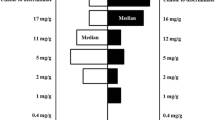Abstract
A specific objective of this 6-week crossover study was to determine how 21 regular smokers of middle tar cigarettes changed their smoking behaviour and uptake of smoke constituents, when switching to either lower tar cigarettes capable of delivering amounts of nicotine similar to a conventional middle tar cigarette (maintained nicotine product), or to conventional low tar/low nicotine cigarettes. Subjects visited the laboratory every 2 weeks for detailed assessment of their smoking behaviour. Weekly per capita consumption was similar for all three cigarettes. They were smoked with variable intensities (low tar > maintained nicotine > middle tar), the tendency being for larger puff volumes, faster puffing and increased puff duration with the low tar cigarettes. The maintained nicotine cigarette was preferred to the middle tar cigarette, although acceptability ratings of the three cigarettes only differed marginally. The nicotine absorbed from the maintained nicotine and middle tar cigarettes was similar and significantly greater than the levels achieved from the low tar cigarettes. Intake of carbon monoxide into the mouth and absorption into the blood stream was lower for the maintained nicotine cigarette than for the middle tar cigarette, with the low tar cigarette occupying an intermediate position. Derived estimates of tar intake suggested reduced intake of tar into the respiratory tract (around 25%) from the maintained nicotine product relative to the middle tar product. The possible advantages of switching to maintained nicotine cigarettes is discussed.
Similar content being viewed by others
References
Armitage AK (1978) The role of nicotine in the tobacco smoking habit. In: Thornton RE (ed) Smoking behaviour. Physiological and psychological influences. Churchill Livingstone, Edinburgh London New York, pp 229–243
Baker RJ, Nelder JA (1978) The GLIM system release 3: generalised linear interactive modeling. Numerical Algorithms Group, Oxford
Beckett AH, Gorrod JW, Jenner P (1971) The analysis of nicotine-1′-N-oxide in urine, in the presence of nicotine and cotinine, and its application to the study of in vivo nicotine metabolism in man. J Pharm Pharmacol 23:55S-61S
Brown LJ (1980) A new instrument for the simultaneous measurement of total hemoglobin, % oxyhemoglobin, % carboxyhemoglobin, % methemoglobin, and oxygen content in whole blood. IEEE Transact Biomed Eng 27:132–138
Creighton DE, Noble MJ, Whewell RT (1978) Instruments to measure, record and duplicate human smoking patterns. In: Thornton RE (ed) Smoking behaviour. Physiological and psychological influences. Churchill Livingstone, Edinburgh London New York, pp 277–288
Feyerabend C, Russell MAH (1980a) Assay of nicotine biological materials: sources of contamination and their elimination. J Pharm Pharmacol 32:178–181
Feyerabend C, Russell MAH (1980b) Rapid gas-liquid chromatographic determination of cotinine in biological fluids. Analyst 105:998–1001
Health Departments of the United Kingdom (1983) Third report of the Independent Scientific Committee on Smoking and Health (Chairman: Froggatt P). HMSO, London, pp 6–7
Jarvis M, Russell MAH (1986) Data note — 4. Sales-weighted tar, nicotine and carbon monoxide yields of U.K. cigarettes: 1985. Br J Addict 81:579–581
Russell MAH (1976) Low-tar medium-nicotine cigarettes: a new approach to safer smoking. Br Med J 1:1430–1433
Russell MAH (1980) The case for medium-nicotine, low-tar, low-carbon monoxide cigarettes. In: Gori GB, Bock FG (eds) Banbury report 3: A safe cigarette? Cold Spring Harbour Laboratory, Cold Spring Harbour, New York, pp 297–310
Russell MAH, Wilson C, Patel UA, Cole PV, Feyerabend C (1973) Comparison of effect on tobacco consumption and carbon monoxide absorption of changing to high and low nicotine cigarettes. Br Med J 4:512–516
Russell MAH, Jarvis MJ, Feyerabend C, Saloojee Y (1986) Reduction of tar, nicotine and carbon monoxide intake in low tar smokers. J Epidemiol Community Health 40:80–85
Stepney R (1981) Would a medium-nicotine, low-tar cigarette be less hazardous to health? Br Med J 283:1292–1296
Sutton SR, Russell MAH, Iyer R, Feyerabend C, Saloojee Y (1982) Relationship between cigarette yields, puffing patterns, and smoke intake: evidence for tar compensation? Br Med J 285:600–603
Woodman G, Newman SP, Pavia D, Clarke SW (1987) The separate effects of tar and nicotine on the cigarette smoking manoeuvre. Eur J Respir Dis 70:316–321
Author information
Authors and Affiliations
Rights and permissions
About this article
Cite this article
Armitage, A.K., Alexander, J., Hopkins, R. et al. Evaluation of a low to middle tar/medium nicotine cigarette designed to maintain nicotine delivery to the smoker. Psychopharmacology 96, 447–453 (1988). https://doi.org/10.1007/BF02180022
Received:
Revised:
Issue Date:
DOI: https://doi.org/10.1007/BF02180022




